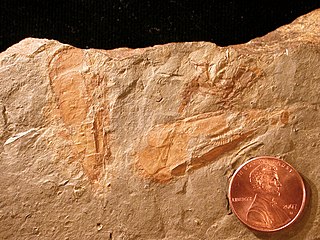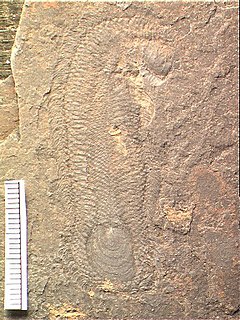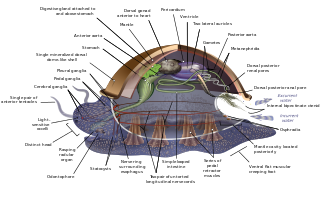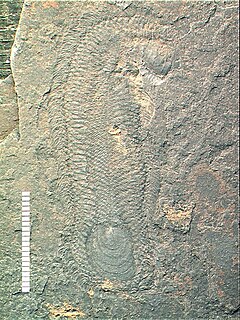
The Ordovician is a geologic period and system, the second of six periods of the Paleozoic Era. The Ordovician spans 41.6 million years from the end of the Cambrian Period 485.4 million years ago (Mya) to the start of the Silurian Period 443.8 Mya.

Hyoliths are animals with small conical shells, known as fossils from the Palaeozoic Era. They are lophophorates, a group which includes the brachiopods.

The halkieriids are a group of fossil organisms from the Lower to Middle Cambrian. Their eponymous genus is Halkieria, which has been found on almost every continent in Lower to Mid Cambrian deposits, forming a large component of the small shelly fossil assemblages. The best known species is Halkieria evangelista, from the North Greenland Sirius Passet Lagerstätte, in which complete specimens were collected on an expedition in 1989. The fossils were described by Simon Conway Morris and John Peel in a short paper in 1990 in the journal Nature. Later a more thorough description was undertaken in 1995 in the journal Philosophical Transactions of the Royal Society of London and wider evolutionary implications were posed.

The evolution of the molluscs is the way in which the Mollusca, one of the largest groups of invertebrate animals, evolved. This phylum includes gastropods, bivalves, scaphopods, cephalopods, and several other groups. The fossil record of mollusks is relatively complete, and they are well represented in most fossil-bearing marine strata. Very early organisms which have dubiously been compared to molluscs include Kimberella and Odontogriphus.

Haplophrentis is a genus of tiny shelled hyolithid which lived in the Cambrian Period. Its shell was long and conical, with the open end protected by an operculum, from which two fleshy arms called helens protruded at the sides. These arms served to elevate the opening of the shells above the sea floor, acting like stilts.

Halwaxiida or halwaxiids is a proposed clade equivalent to the older orders Sachitida He 1980 and Thambetolepidea Jell 1981, loosely uniting scale-bearing Cambrian animals, which may lie in the stem group to molluscs or lophotrochozoa. Some palaeontologists question the validity of the Halwaxiida clade.
A number of assemblages bear fossil assemblages similar in character to that of the Burgess Shale. While many are also preserved in a similar fashion to the Burgess Shale, the term "Burgess Shale type fauna" covers assemblages based on taxonomic criteria only.

The end-Botomian mass extinction event, also known as the late early Cambrian extinctions, refer to two extinction intervals that occurred during Stages 4 and 5 of the Cambrian Period, approximately 513 to 509 million years ago. Estimates for the decline in global diversity over these events range from 50% of marine genera up to 80%. Among the organisms affected by this event were the small shelly fossils, archaeocyathids, trilobites, brachiopods, hyoliths, and mollusks.
The small shelly fauna, small shelly fossils (SSF), or early skeletal fossils (ESF) are mineralized fossils, many only a few millimetres long, with a nearly continuous record from the latest stages of the Ediacaran to the end of the Early Cambrian Period. They are very diverse, and there is no formal definition of "small shelly fauna" or "small shelly fossils". Almost all are from earlier rocks than more familiar fossils such as trilobites. Since most SSFs were preserved by being covered quickly with phosphate and this method of preservation is mainly limited to the Late Ediacaran and Early Cambrian periods, the animals that made them may actually have arisen earlier and persisted after this time span.
The Cambrian explosion or Cambrian radiation was an event approximately 541 million years ago in the Cambrian period when practically all major animal phyla started appearing in the fossil record. It lasted for about 13 – 25 million years and resulted in the divergence of most modern metazoan phyla. The event was accompanied by major diversifications in other groups of organisms as well.

The Mount Cap Formation is a geologic formation exposed in the Mackenzie Mountains, northern Canada. It was deposited in a shallow shelf setting in the late Early Cambrian, and contains an array of Burgess Shale-type microfossils that have been recovered by acid maceration.
The cephalopods have a long geological history, with the first nautiloids found in late Cambrian strata, and purported stem-group representatives present in the earliest Cambrian lagerstätten.
Stenothecoida is a taxon of bivalved fossils from the Early to middle Cambrian period. They look a bit like brachiopods or bivalve molluscs.
Mobergella is a millimetric Lower Cambrian shelly fossil of unknown affinity, usually preserved in phosphate and particularly well known from Swedish strata, where it is diagnostic of lowermost Cambrian rocks. Originally interpreted as a monoplacophoran, the circular, cap-shaped shell resembles a hyolith operculum, with concentric rings on its upper surface, and seven pairs of internal muscle scars. It is never found in association with a conch, and its affinity therefore remains undetermined. Nevertheless, its heavy musculature does seem to indicate that it functioned as an operculum.
A megabias, or a taphonomic megabias is a large scale pattern in the quality of the fossil record that affects paleobiologic analysis at provincial to global levels and at timescales usually exceeding ten million years. It can result from major shifts in intrinsic and extrinsic properties of organisms, including morphology and behaviour in relation to other organisms, or shifts in the global environment, which can cause secular or long-term cyclic changes in preservation.
Ladatheca is a genus of hyolith that closely resembles Turcutheca. It has a straight conch with a smooth internal surface, and is found with what may be its operculum.
The orthothecids are one of the two hyolith orders.
The concept of the three great evolutionary faunas of marine animals from the Cambrian to the present was introduced by Jack Sepkoski in 1981 using factor analysis of the fossil record. An evolutionary fauna typically displays an increase in biodiversity following a logistic curve followed by extinctions.

The Milwaukee Formation is a fossil-bearing geological formation of Middle Devonian age in Milwaukee County, Wisconsin. It stands out for the exceptional diversity of its fossil biota. Included are many kinds of marine protists, invertebrates, and fishes, as well as early trees and giant fungi.
Angarella is an early palaeozoic genus of problematic fossils, long held to belong to the molluscs based on supposed similarities in its musculature to that of hyoliths and mobergellids, but now considered to represent a brachiopod based on its calcitic mineralogy and paired symmetrical valves.









